When you try to think of animals that start with U, how many do you come up with? It’s easy to get stuck after a handful. Luckily for you, I’ve pulled together a list of over 130 animals that start with U.
Before you give my list a look, take a second to see how many you can come up with on your own. Then dive into my list to expand your knowledge.
List of 130+ Animals That Start With U
My list of over 130 animals that start with U is broken down into several different types of animals. After all, it’s helpful to split off mammals from birds and other types of animals.
As a note, I tried to steer clear of scientific names and only include animals with common names starting with the letter U. But I couldn’t help myself from adding a scientific name or two of creatures I truly love. Here’s a breakdown of how many different animals starting with U are included by category:
- Mammals: 29
- Birds: 31
- Reptiles: 7
- Amphibians: 7
- Fish: 49
- Invertebrates: 7
That’s a grand total of 130 animals that start with U.
Mammals: 29 Animals that Start with U
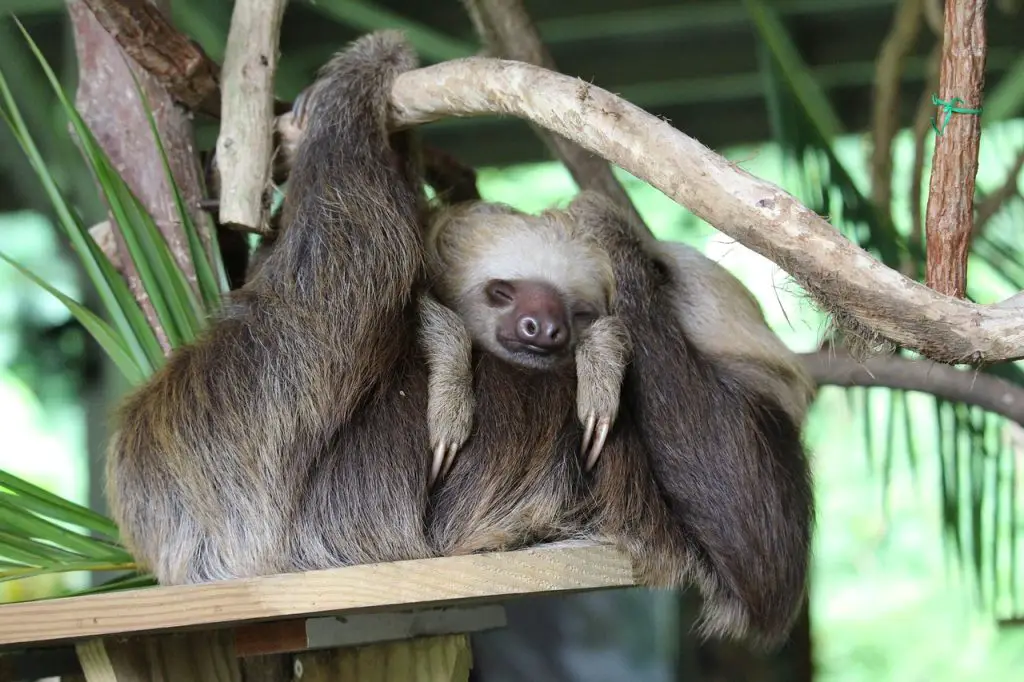
- Uakari: The Uakari is a striking monkey known for its bright red face, hairless except for a few tufts. It is found in the Amazon rainforest. This unique appearance is a result of a diet rich in fruits and a sign of good health.
- Unita Chipmunk: The Uinta Chipmunk is native to the western United States. You’ll often find it in coniferous forests, thriving on a diet of seeds, nuts, and insects.
- Unita Ground Squirrel: Also found in the western United States, the Uinta Ground Squirrel is a diurnal rodent that hibernates during the winter months. It resides in meadows and alpine tundra.
- Urial: The Urial is a wild sheep native to central Asia, recognized for its distinctive curved horns and shaggy coat. These herbivores inhabit arid mountainous regions.
- Unau: The Unau, or Two-Toed Sloth, is a slow-moving arboreal mammal found in Central and South America. Recognized by its sluggish nature, it spends most of its life hanging upside down from trees.
- Uganda Kob: The Uganda Kob is a subspecies of the kob antelope found in central and East Africa. Noted for its elegant lyre-shaped horns, it inhabits grassy savannas and floodplains.
- Ucayali Spiny Mouse: The Ucayali Spiny Mouse is a rodent native to South America, dwelling in the Amazon rainforest. Its spiky fur provides protection against predators in its dense forest habitat.
- Ugandan Shrew: The Ugandan Shrew is a small insect-eating mammal endemic to Uganda. With a pointed snout and a slender body, it navigates its forest environment efficiently in search of prey.
- Ultimate Shrew: Known for its minuscule size, the Ultimate Shrew holds the title of one of the world’s smallest mammals. Native to the Philippines, it is an elusive and diminutive insectivore.
- Unadorned Rock Wallaby: The Unadorned Rock Wallaby is a marsupial endemic to Australia, often found in rocky habitats. With its agile movements, it navigates steep terrains with ease, displaying impressive leaping abilities.
- Umboi Tube-nosed Fruit Bat: The bat is endemic to Papua New Guinea. You can identify it by its unique tubular nostrils. It plays a crucial role in pollination and seed dispersal within its rainforest habitat.
- Underwood’s Long-nosed Bat: This bat species is found in Southeast Asia, known for its distinctive long nose and wide wingspan. It primarily feeds on insects and plays a vital role in maintaining insect populations.
- Underwood’s Bonneted Bat: Underwood’s Bonneted Bat has a distinctive large “bonnet” or flap of skin on its head. This nocturnal bat is an efficient hunter, preying on insects in flight. It is native to Central America.
- Underwood’s Pocket Gopher: The Underwood’s Pocket Gopher is native to North America. The burrowing rodent with specialized cheek pouches for transporting food. It contributes to soil aeration through its extensive tunneling.
- Underwood’s Water Mouse: This semi-aquatic rodent, found in Central America has adapted to both terrestrial and aquatic habitats.
- Unalaska Collared Lemming: The lemming is endemic to the Aleutian Islands in Alaska. It is a small, burrowing mammal adapted to the Arctic tundra.
- Unexpected Cotton Rat: The Unexpected Cotton Rat, native to Central America, is recognized for its soft fur and a tail with a tuft at the end. It is an essential prey item for various predators in its ecosystem.
- Unicolored Oldfield Mouse: Found in Central America, the Unicolored Oldfield Mouse is a small rodent with a uniform coat color. It is a nocturnal species, foraging for seeds, fruits, and insects.
- Unicolored Tree Rat: The Unicolored Tree Rat, native to South America, is a nocturnal species that primarily inhabits trees. Its soft fur and long tail contribute to its agile movements.
- Unicolored Arboreal Rice Rat: This small rodent, found in Central America, is arboreal, spending much of its life in trees. It plays a role in seed dispersal within its forest habitat.
- Unstriped Ground Squirrel: The Unstriped Ground Squirrel, found in North America, is characterized by its burrowing behavior and contributes to soil health through its digging activities.
- Unstriped Tube-nosed Bat: Endemic to the Philippines, the Unstriped Tube-nosed Bat has a unique tubular nose and is an insectivorous bat with a specialized diet.
- Ural Field Mouse: Native to Europe and Asia, the Ural Field Mouse is a small mammal with a wide distribution, adapting to various habitats, including grasslands and forests.
- Urastk Mouse-like Hamster: Found in Kazakhstan, the Urastk Mouse-like Hamster is a burrowing rodent with a stocky build. It is well-adapted to the arid steppes of Central Asia.
- Usambara Shrew: The Usambara Shrew, native to Tanzania, is a small insectivorous mammal known for its slender body and pointed snout. It resides in the montane forests of the Usambara Mountains.
- Ussuri Shrew: The Ussuri Shrew, found in East Asia, is a small insectivore with a pointed snout. It is adaptable to various habitats, including forests and grasslands.
- Utah Prairie Dog: The Utah Prairie Dog, endemic to the United States, is a keystone species in its grassland habitat. It plays a crucial role in ecosystem dynamics through its burrowing activities.
- Ussuri Tube-nosed Bat: Endemic to the Russian Far East, the Ussuri Tube-nosed Bat has a distinctive tubular nose and is adapted to a forested habitat.
- Uganda Mangabey: The Uganda Mangabey is a species of monkey found in Central Africa, recognized for its long tail and cheek pouches. It inhabits tropical rainforests and plays a vital role in seed dispersal.
Birds: 31 Animals that Start with U
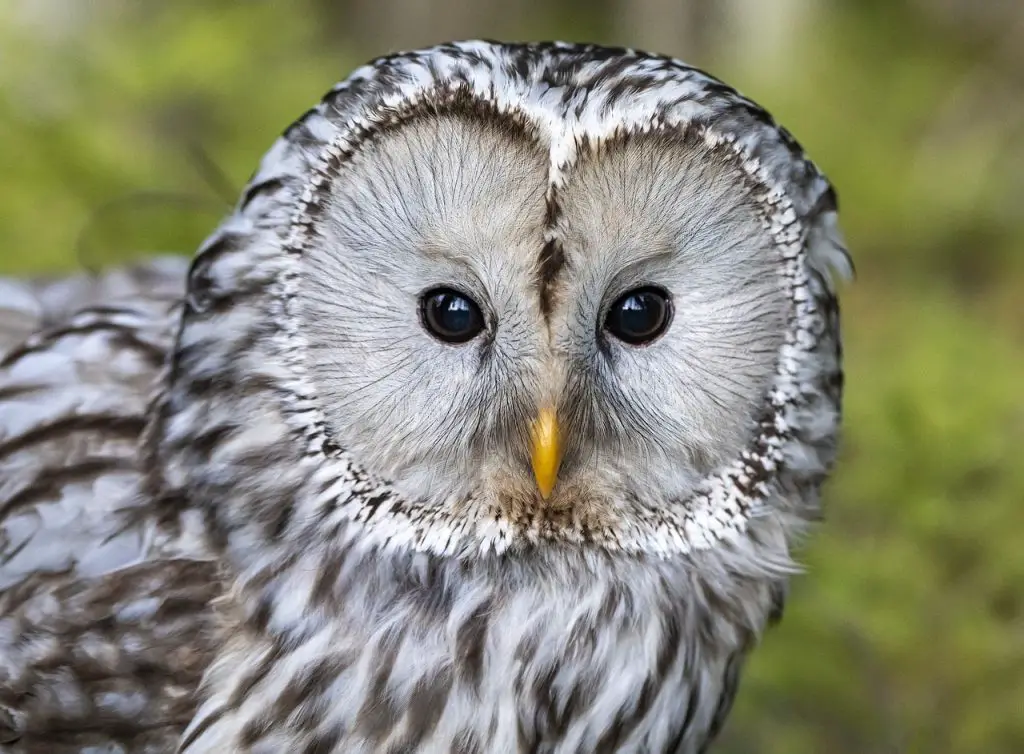
- Umbrellabird: The Umbrellabird, found in Central and South America, is recognized for its distinctive umbrella-like crest of feathers on its head, making it a captivating and charismatic species.
- Uguisu (Japanese Bush Warbler): The Uguisu, or Japanese Bush Warbler, is a small bird known for its melodious and often secretive song, symbolizing the arrival of spring in Japan.
- Udzungwa Partridge: Endemic to the Udzungwa Mountains in Tanzania, the Udzungwa Partridge is a ground-dwelling bird facing conservation challenges due to habitat loss and fragmentation.
- Ultramarine Kingfisher: The Ultramarine Kingfisher, native to the Solomon Islands, is a striking bird with vibrant blue plumage, residing in the dense rainforests of the region.
- Ultramarine Grosbeak: Found in the Marquesas Islands, the Ultramarine Grosbeak is a rare and elusive bird with distinctive blue and black markings, showcasing the unique avian diversity of the Pacific.
- Ultramarine Flycatcher: Native to the Himalayan region, the Ultramarine Flycatcher is a small and colorful bird known for its brilliant ultramarine-blue plumage and agile insect-catching abilities.
- Uganda Woodland Warbler: This warbler species is native to Uganda and is often found in montane forests, contributing to the rich avian diversity of the East African highlands.
- Ultramarine Lorikeet: The Ultramarine Lorikeet, endemic to the Solomon Islands, is a parrot species characterized by its vibrant blue and green feathers and its preference for tropical lowland rainforests.
- Ural Owl: Widely distributed in Europe and Asia, the Ural Owl is a nocturnal predator known for its striking appearance, featuring a distinctive facial disc and tufted “ears.”
- Upland Sandpiper: This migratory bird, often found in grasslands and prairies of North America, is recognized for its distinctive appearance, long bill, and aerial display during courtship.
- Unicolored Blackbird: The Unicolored Blackbird, native to South America, is characterized by its entirely black plumage, making it a visually striking member of the icterid family.
- Uvea Parakeet: Endemic to Wallis Island in the South Pacific, the Uvea Parakeet is a small parrot species facing conservation challenges due to habitat loss and introduced predators.
- Unicolored Jay: Found in Central and South America, the Unicolored Jay is recognized for its predominantly dark plumage and its presence in various forested habitats.
- Uniform Finch: Native to South America, the Uniform Finch is a small songbird known for its distinctive vocalizations and its preference for open habitats.
- Upland Goose: The Upland Goose, found in the southern part of South America, is notable for its adaptability to diverse habitats, including grasslands, coasts, and wetlands.
- Uniform Crake: Inhabiting wetlands and marshes of South America, the Uniform Crake is a small bird characterized by its subtle and uniform brown plumage.
- Uniform Treehunter: Endemic to Brazil, the Uniform Treehunter is a passerine bird with a distinctive olive-brown plumage, residing in montane forests.
- Upcher’s Warbler: This warbler species, breeding in parts of Europe and western Asia, is known for its distinctive song and its presence in a variety of habitats, including woodlands and gardens.
- Upland Buzzard: The Upland Buzzard, found in parts of Asia, Europe, and Africa, is a raptor species often observed in open habitats, displaying impressive soaring and hunting skills.
- Urich’s Tyrannulet: Endemic to the Andes of South America, Urich’s Tyrannulet is a small flycatcher known for its presence in high-altitude cloud forests.
- Ursula’s Sunbird: Native to Africa, Ursula’s Sunbird is a species of sunbird with vibrant plumage, contributing to the colorful array of birds in sub-Saharan ecosystems.
- Ussher’s Flycatcher: This small passerine bird is found in West Africa and is known for its insect-catching behavior and presence in dense forested areas.
- Usambara Weaver: Endemic to the Usambara Mountains in Tanzania, the Usambara Weaver is a social and colonial nesting bird, displaying intricate woven nests in trees.
- Unstreaked Tit-Tyrant: Native to South America, the Unstreaked Tit-Tyrant is a small bird characterized by its distinctive crest and its presence in high-altitude cloud forests.
- Undulated Antpitta: The Undulated Antpitta, found in the Andes of South America, is a ground-dwelling bird known for its cryptic plumage and habit of foraging for insects and invertebrates on the forest floor.
- Undulated Antshrike: Native to Central and South America, the Undulated Antshrike is a striking bird with distinct undulating patterns on its plumage. It is often found in dense vegetation, preying on insects and small invertebrates.
- Undulated Tinamou: The Undulated Tinamou, native to South America, is a ground-dwelling bird known for its distinctive undulating patterns on its plumage. It is primarily a forest-dwelling species that forages for seeds and small invertebrates.
- Uluguru Violet-backed Sunbird: Endemic to the Ulugwruru Mountains in Tanzania, the Uluguru Violet-backed Sunbird is a colorful and striking bird known for its iridescent plumage. It plays a crucial role in pollination as it feeds on nectar from various flowering plants in its montane forest habitat.
- Unicolored Antwren: Native to South America, the Unicolored Antwren is a small and inconspicuous bird known for its unicolored plumage, often shades of brown or gray. It is typically found in lowland forests and is known for its active foraging behavior in the understory.
- Unicolored Thrush: The Unicolored Thrush, found in South America, is a medium-sized bird with a single-colored plumage, often a mix of brown and gray tones. It is known for its melodious song and is often found in forested habitats.
- Unicolored Tapaculo: Endemic to the Andes of South America, the Unicolored Tapaculo is a small, elusive bird known for its unicolored plumage and cryptic behavior. It forages on the forest floor, often in dense undergrowth, and is recognized for its distinct vocalizations.
Reptiles: 7 Animals that Start with U
- Upland Swamp Skink (Liopholis inornata): Endemic to Australia, the Upland Swamp Skink is a slender lizard species adapted to swampy habitats in upland regions. Its cryptic coloration and streamlined body allow it to navigate the dense vegetation of its environment.
- Utah Green Side-blotched Lizard (Uta stansburiana uniformis): The Utah Green Side-blotched Lizard is a subspecies found in the arid regions of western North America. Recognized for its vibrant green coloration and distinct side-blotches, it plays a vital role in maintaining insect populations through its foraging behavior.
- Upland Swamp Turtle (Emydura macquarii signata): Endemic to Australia, the Upland Swamp Turtle is a subspecies of the widespread Macquarie River Turtle. Thriving in freshwater habitats, it is known for its distinctive markings on the carapace and is often encountered basking on logs or rocks along waterways.
- Upemba Mud Turtle: The Upemba Mud Turtle, native to Central Africa, is a semi-aquatic turtle species found in freshwater habitats. Known for its flattened appearance and preference for slow-moving waters, it is an important part of the aquatic ecosystems it inhabits.
- Urbe’s False Cat-eyed Snake: Urbe’s False Cat-eyed Snake is a species of snake found in parts of South America. With its distinct coloration and eye-like markings, it is well-adapted to its forested habitat and plays a role in controlling local rodent populations.
- Uzzell’s Lizard: Uzzell’s Lizard is a species found in Central America, known for its arboreal habits and striking coloration. This lizard contributes to the biodiversity of its habitat and is often observed in forested areas where it can utilize its climbing abilities.
- Urutu Snake (Bothrops alternatus): Also known as the “Urutu,” it is a venomous pit viper species found in South America, particularly in Brazil and Argentina. Recognized for its distinctive pattern and potentially dangerous bite, the Urutu is a member of the Bothrops genus.
Amphibians: 7 Animals that Start with U
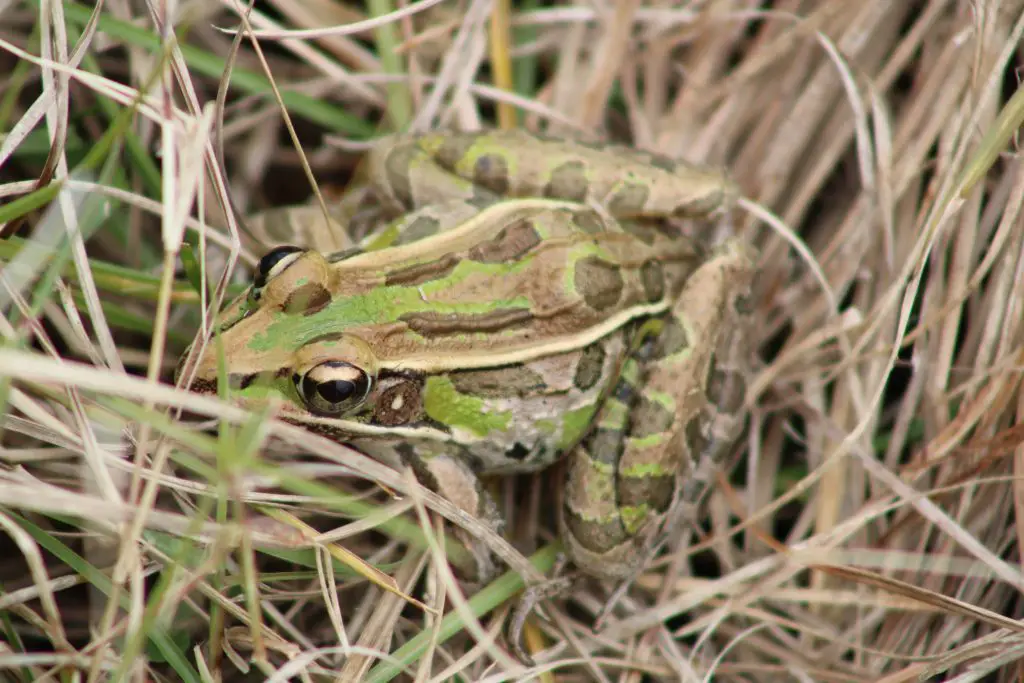
- Upland Chorus Frog (Pseudacris feriarum). Found in North America, this small frog species is known for its distinctive call and is adaptable to various habitats.
- Upland Swamp Frog (Limnodynastes convexiusculus). Native to Australia, this frog species is often found in upland swampy areas and has a distinctive concave appearance.
- Urutu Toad (Rhinella margaritifera). Found in South America, the Urutu Toad is a member of the Bufonidae family and inhabits a range of environments.
- Umar Treefrog: The Umar Treefrog is a species of treefrog found in certain regions of West Papua. It is known for its arboreal lifestyle and often resides in trees and vegetation.
- Usambara Blue-bellied Frog (Hylarana usambarica). Endemic to the Usambara Mountains in Tanzania, this striking blue-bellied frog inhabits montane forests and contributes to the region’s unique amphibian diversity.
- Usambara Torrent Frog (Hylarana galamensis). Also found in the Usambara Mountains, this species of torrent frog is adapted to fast-flowing streams and watercourses, showcasing adaptations for life in aquatic environments.
- Uganda Clawed Frog (Xenopus ruwenzoriensis). This clawed frog species is native to Uganda and is a member of the Xenopus genus. It is characterized by its flattened body and distinctive claws on its hind limbs, adapted for a semi-aquatic lifestyle.
Fish: 49 Animals that Start with U
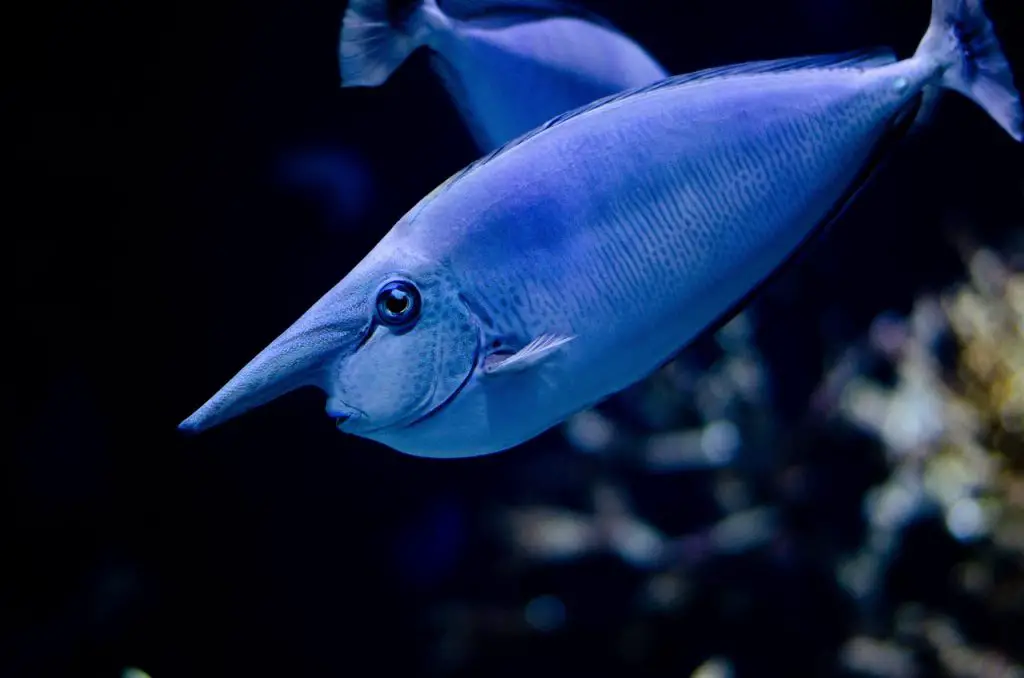
- Uaru Cichlid (Uaru amphiacanthoides). The Uaru Cichlid, native to South America, has a distinctive appearance with a round body and a unique facial pattern.
- Umbrella Mouth Gulper (Asterophysus batrachus). The Umbrella Mouth Gulper, found in the Amazon Basin, is a predatory fish named for its wide mouth, resembling an open umbrella.
- Unicornfish (Naso genus). Unicornfish, found in tropical waters, is known for the elongated horn-like projection on their foreheads.
- Upside-Down Catfish (Synodontis nigriventris). Originating from Africa, this catfish species is known for its habit of swimming upside down, often clinging to the undersides of aquatic plants.
- Utah Sucker (Catostomus ardens). Native to North America, the Utah Sucker is a freshwater fish found in river systems of the western United States.
- Utah Lake Sculpin (Cottus echinatus): Endemic to Utah Lake, this sculpin species is adapted to cold, clear waters and plays a role in local aquatic ecosystems.
- Utah Chub (Gila atraria). Found in various water bodies in the western United States, the Utah Chub is a freshwater fish known for its adaptability to diverse habitats.
- U-Mark Sandperch (Parapercis u-marki). Native to the Indo-Pacific region. The U-Mark Sandperch is a colorful reef fish often found in sandy or rubble areas.
- Uganda Nothobranch (Nothobranchius ugandensis). Endemic to Uganda. This colorful killifish species is known for its vibrant patterns and is often kept in aquariums.
- Ukrainian Brook Lamprey (Eudontomyzon mariae). Found in Eastern Europe, this lamprey species inhabits freshwater environments and is known for its unique life cycle.
- Umatilla Dace (Rhinichthys umatilla). Native to the Pacific Northwest of North America, the Umatilla Dace is a minnow species typically found in clear streams.
- Umbrella Cichlid (Mesonauta festivus). Native to South America, the Umbrella Cichlid is popular in the aquarium trade for its distinctive appearance and behavior.
- Umbee Cichlid (Cichla umbrifera). Found in South America, the Umbee Cichlid is a large and aggressive predatory fish known for its striking coloration.
- Ulrey’s Tetra (Bryconamericus ulreyi). Native to North America, Ulrey’s Tetra is a small freshwater fish found in rivers and streams.
- U-Spot Wrasse (Halichoeres chrysus). You can find colorful wrasse species in the Indo-Pacific. It has vibrant colors and distinct markings.
- Umpqua Chub (Oregonichthys kalawatseti). Endemic to Oregon, the Umpqua Chub is a minnow species inhabiting streams and rivers in the Umpqua River basin.
- Umpqua Dace (Rhinichthys evermanni). Native to the Umpqua River basin, this dace species is a small, freshwater fish found in clear, cool streams.
- Umpqua Squawfish (Ptychocheilus umpquae). Also known as Northern Pikeminnow, this large predatory fish is found in rivers of the Pacific Northwest.
- Unarmed Dwarf Monocle Bream (Parascolopsis inermis). This dwarf cichlid species is native to South America and is known for its intricate color patterns.
- Unarmored Threespine Stickleback (Gasterosteus aculeatus williamsoni). Found in North America, this stickleback species lacks the bony plates typical of other sticklebacks.
- Undulated Moray (Gymnothorax undulatus). Distributed in tropical seas, the Undulated Moray is a large eel known for its distinctive undulating pattern.
- Uncinate Sculpin (Artedius harringtoni). Native to the North Pacific, the Uncinate Sculpin is a bottom-dwelling fish found in rocky habitats.
- Underjaw Kingfish (Hypseleotris spp.). Found in Australia and New Guinea, these freshwater fish are known for their diverse species and habitats.
- Unicolored Moray (Gymnothorax vicinus). Inhabiting coral reefs, the Unicolored Moray is a slender eel species with a uniform coloration.
- Unicorn Crestfish (Aristostomias scintillans). Found in deep-sea environments, the Unicorn Crestfish is a mesopelagic fish known for its elongated body and crest-like fin.
- Unicorn Icefish (Bathydraco marri). Native to the Southern Ocean, the Unicorn Icefish is an Antarctic fish species adapted to cold waters.
- Unicorn Leatherjacket (Aluterus monoceros). Inhabiting tropical and subtropical waters, the Unicorn Leatherjacket is a unique reef-dwelling fish.
- Union Snook (Petenia splendida). Native to Central America, the Union Snook is a freshwater fish species often kept in aquariums for its vibrant colors.
- Unicorn Sole (Achirus klunzingeri). Found in the Indo-Pacific, the Unicorn Sole is a flatfish species characterized by its unique body shape.
- Upjaw Barb (Opsarius pulchellus). Native to Southeast Asia, the Upjaw Barb is a freshwater fish often found in streams and rivers.
- United-lip Gudgeon (Hypseleotris spp.). Found in freshwater habitats in Australia and New Guinea, United-lip Gudgeons are known for their diverse species and adaptability.
- Upland Bully (Gobiomorphus breviceps). Endemic to New Zealand, the Upland Bully is a freshwater fish species commonly found in streams and rivers.
- Upper Grijalva Livebearer (Poeciliopsis gracilis). Native to Mexico, the Upper Grijalva Livebearer is a species of fish known for its viviparous reproduction, giving birth to live fry.
- Upper Zambesi Labeo (Labeo mesops). Inhabiting the Upper Zambesi River in Africa, this species of Labeo is a freshwater fish with a distinctive appearance.
- Upper Zambesi Squeaker (Synodontis zambezensis). This catfish species is found in the Upper Zambesi River and is known for the squeaking sounds it produces.
- Upper Zambezi Nembwe (Serranochromis robustus). Native to the Zambezi River, the Upper Zambezi Nembwe is a predatory fish species found in African freshwater habitats.
- Upper Zambezi Yellowfish (Labeobarbus spp.). Yellowfish species in the Upper Zambezi River contribute to the region’s freshwater biodiversity and are popular among anglers.
- Upside Down Harptail (Polyipnus matame). Inhabiting deep-sea environments, the Upside Down Harptail is a mesopelagic fish known for its unique body shape and behavior.
- Upside Down Goby (Periophthalmus spp.). Found in intertidal zones and mangrove areas, Upside Down Gobies are known for their ability to move on land and breathe air.
- Upside Down Catfish (Synodontis nigriventris). This catfish species, found in African rivers, is known for its habit of swimming upside down, especially when resting.
- Urchin Clingfish (Diademichthys lineatus). Inhabiting coral reefs, the Urchin Clingfish is a small fish species that is often associated with sea urchins.
- Upturned Snout Rattail (Coryphaenoides rupestris). Found in deep-sea environments, the Upturned Snout Rattail is a deep-sea fish with a distinctive upward-pointing snout.
- Uruguay River Sprat (Sprattus uruguayensis). Inhabiting coastal waters of South America, the Uruguay River Sprat is a small fish species that contributes to marine ecosystems.
- Uruguay Tetra (Aphyocharax anisitsi). Native to South America, the Uruguay Tetra is a freshwater fish species often kept in aquariums for its schooling behavior.
- Uruguayan Eartheater (Geophagus brasiliensis). This cichlid species is found in South America and is known for its habit of sifting through substrate in search of food.
- Usangu Lampeye (Aplocheilichthys spilauchen). Endemic to Tanzania, the Usangu Lampeye is a small fish species often found in seasonal water bodies.
- Ussuri Catfish (Pseudobagrus ussuriensis): Native to East Asia, the Ussuri Catfish is a freshwater species found in rivers and lakes.
- Usumacinta Sea Catfish (Ariopsis seemanni): The Usumacinta Sea Catfish is a marine species known for its adaptability to brackish water.
- Ussuri Sharpbelly (Hemiculter eigenmanni). The Ussuri Sharp Belly is a freshwater fish species found in rivers of East Asia.
Invertebrates: 7 Animals that Start with U
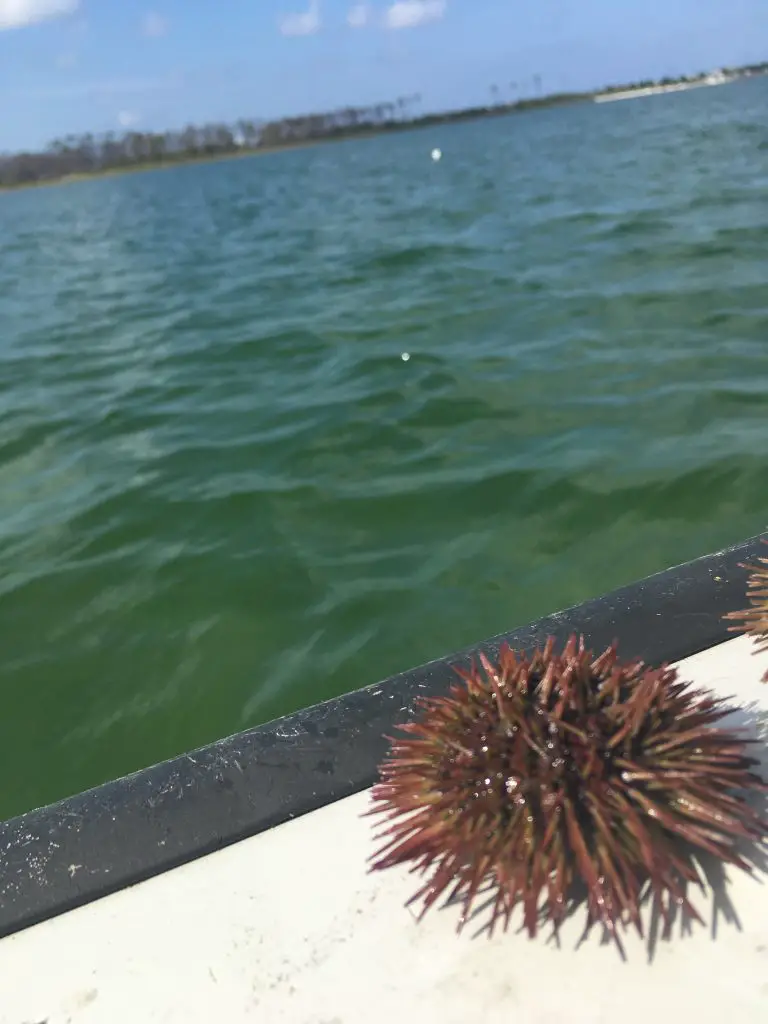
- Umbrella Slug (Umbraculum umbraculum): A species of sea slug with a broad, umbrella-shaped body found in coastal waters.
- Upside-Down Jellyfish (Cassiopea spp.): Jellyfish species that typically rest upside down on the seafloor. This exposes their oral arms to capture prey.
- Ulysses Butterfly (Papilio ulysses): A large and colorful butterfly found in Australia, Indonesia, and Papua New Guinea.
- Urchin (Echinoidea): A class of echinoderms characterized by their spiny, spherical bodies found in marine environments.
- Underwing Moth (Catocala spp.): A group of nocturnal moths known for their cryptic wing patterns. The patterns resemble bark, lichen, or leaves.
- Unionidae: A family of freshwater mussels. You can find them around the world.
- Uca Crab (Genus Uca): Commonly known as fiddler crabs. Uca is a genus of small, colorful crabs found in intertidal zones along shorelines. They have distinctive asymmetric claws, with males using one enlarged claw for courtship displays.
My Favorite Animals That Start With U
Unionidae is a scientific family of freshwater mussels. While these unassuming creatures tend to fly under the radar, these are my favorite animals that start with the letter U.
It’s possible that my love for all Unionidae stems from my years working as a freshwater mussel biologist in the state of Florida. (Okay, that’s definitely where this unique affinity comes from). But freshwater mussels are surprisingly amazing creatures.
For one, these often hidden invertebrates spend their lives filtering river water. Without freshwater mussels, the water quality in the rivers they call home would be significantly worse. Additionally, these critters have some wild adaptations. For example, some freshwater mussels have adapted to look like a fish to attract little fish. When the little fish gets close enough, the mussel will clamp down on the fish. While the fish is momentarily trapped between two shells, the mussel releases glochidia, which is the larval stage of freshwater mussels. The glochidium then attaches to the fish’s gills to grow like a parasite until they fall off as small freshwater mussels. It’s an amazing evolutionary adaptation that helps freshwater mussels move their offspring upstream.
Here’s a look at a beautiful Unionidae mussel I found in the Suwannee River:
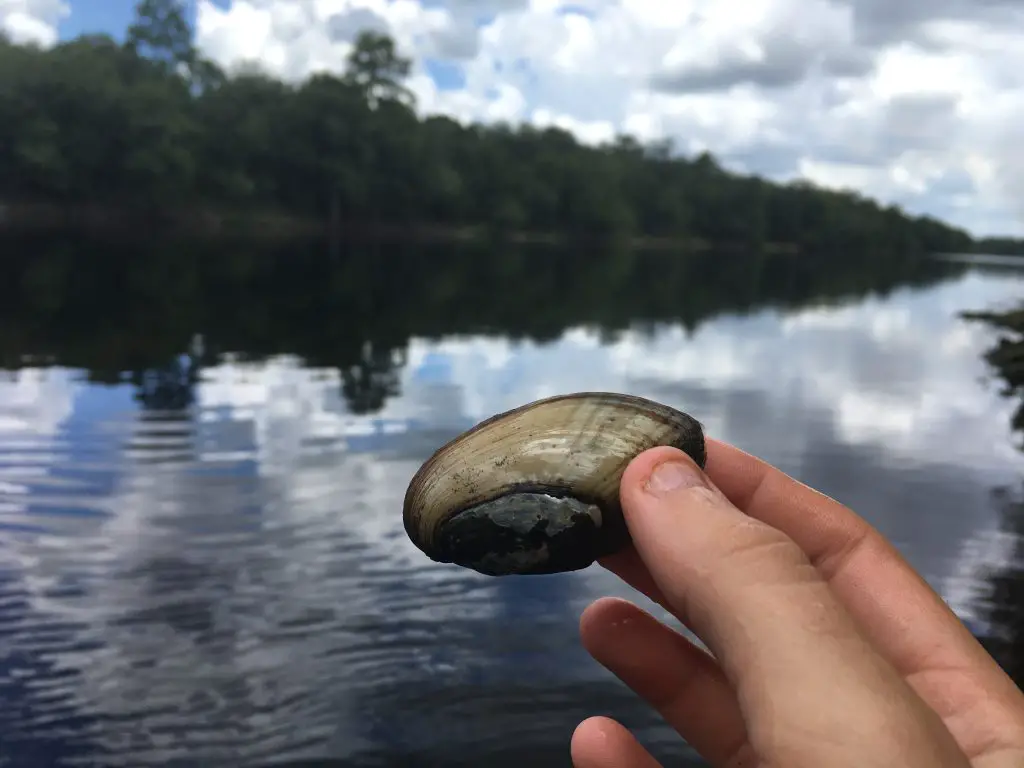
The Bottom Line on Animals that Start with U
While animals that start with U might not spring to mind immediately, a bit of digging has over 130 animals that start with U. Can you add any to this list?